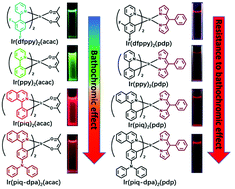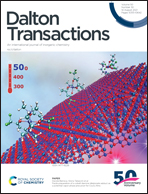New phosphorescent iridium(iii) dipyrrinato complexes: synthesis, emission properties and their deep red to near-infrared OLEDs†
Abstract
A series of heteroleptic Ir(III) complexes composed of two cyclometalated C^N ligands and one dipyrrinato ligand used as an ancillary ligand are synthesized and characterized. With the introduction of a fluorine atom, phenyl ring or diphenylamino group into both C^N ligands and by keeping the ancillary ligand unchanged, these Ir(III) dipyrrinato phosphors do not show an obvious shift in their emission bands. They exhibit emissions extending well into the near-infrared region with an intense band located at around 685 nm in both photo- and electroluminescence spectra, and the deep red to near-infrared organic light emitting diodes (OLEDs) based on them afforded a maximum external quantum efficiency of 2.8%. Density functional theory (DFT) calculations show that both the electronic contributions on the lowest unoccupied molecular orbitals (LUMOs) and the highest energy semi-occupied molecular orbitals (HSOMOs) are mainly localized on the dipyrrinato ligand, indicating that the ancillary ligand, which remains unchanged in this series, exhibits a lower triplet state energy in the iridium phosphors than those involving the C^N ligands. Therefore a switch from “(C^N)2Ir” to dipyrrinato ligand-based emission is observed in these iridium(III) complexes.

- This article is part of the themed collection: Dalton turns 50 – celebrating our board members past and present


 Please wait while we load your content...
Please wait while we load your content...